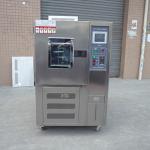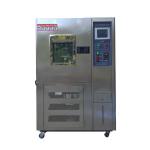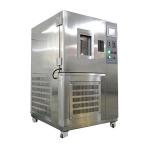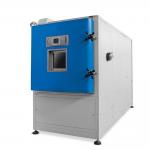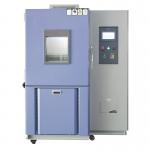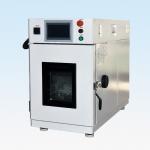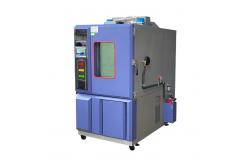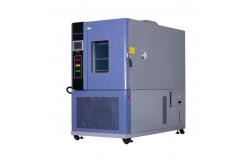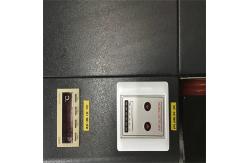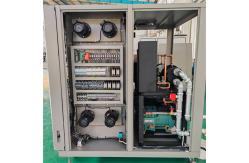In the highly competitive home appliance industry, ensuring the
durability, functionality, and safety of products is essential. The
Customized Environmental Test Chambers for Home Appliances play a
crucial role in simulating a wide range of real-world conditions
that these appliances will encounter during their lifespan. This
enables manufacturers to identify and address potential issues
before the products reach the hands of consumers. These specialized test chambers are designed to evaluate the
performance of various home appliances, including refrigerators,
washing machines, air conditioners, microwave ovens, and
televisions. They serve appliance manufacturers, quality control
laboratories, and research institutions. The main objective is to
subject the appliances to different temperature, humidity, and
other environmental factors, as well as mechanical stresses, to
determine how they will function and hold up over time. By doing
so, manufacturers can optimize product designs, improve
manufacturing processes, and enhance the overall quality and
reliability of their home appliances. - Sturdy and Spacious Design
- The chamber is constructed with a strong steel framework that
provides excellent stability and durability. The exterior is coated
with a corrosion-resistant finish to withstand the rigors of
testing and different environmental conditions. The interior is
large enough to accommodate a wide range of home appliances, from
compact countertop appliances to full-sized refrigerators and
washing machines. The walls are lined with a thermally conductive
and insulating material to ensure proper temperature control and
energy efficiency. The door is a heavy-duty component, featuring a
reliable sealing mechanism and a locking system to maintain a
consistent and controlled environment inside the chamber. A clear
viewing window, made of tempered glass, allows for easy monitoring
of the testing process without affecting the internal conditions.
- Precision Environmental Control Systems
- Temperature Control: Capable of maintaining a temperature range
from -30°C to +60°C, with an accuracy of ±1°C. It utilizes a
combination of compressor-based refrigeration and electric heating
elements. The control system is equipped with multiple temperature
sensors placed strategically throughout the chamber to ensure
uniform temperature distribution. The user-friendly control panel
allows for precise programming of temperature profiles, including
gradual temperature changes, constant temperature holds, and cyclic
temperature sequences, mimicking the temperature variations that
home appliances may experience, such as the cold environment in a
freezer, the warm air in a kitchen during cooking, or the
fluctuating temperatures in a storage room.
- Humidity Control: The humidity control system can achieve humidity
levels from 20% to 90% RH, with an accuracy of ±3% RH. It employs a
steam injection humidifier and a condenser dehumidifier, integrated
with a well-designed air circulation system. Humidity sensors
continuously monitor the internal humidity, and the control system
makes real-time adjustments to maintain the desired humidity
levels. This is important for testing the effects of moisture on
appliances, such as the rusting of metal parts in a humid
environment, the performance of electronic components in high
humidity, and the drying efficiency of a washing machine in
different humidity conditions.
- Dust and Particle Simulation: The chamber can also introduce
controlled amounts of dust and particles into the environment to
test the appliance's resistance to dirt and debris. This is
particularly relevant for appliances like air conditioners and
vacuum cleaners, as it helps determine how well their filters and
internal mechanisms can handle particulate matter. The dust
injection system is adjustable, allowing for different particle
sizes and concentrations to be used, simulating various real-world
dust and dirt scenarios.
- Mechanical Stress Testing Capabilities
- Vibration Testing: The chamber is equipped with a vibration table
that can generate vibrations with frequencies ranging from 5 Hz to
500 Hz and amplitudes adjustable from 0.5 mm to 20 mm. This is
useful for testing the durability of appliance components, such as
the motors and fans, under the mechanical stress of vibrations that
may occur during operation or transportation. The vibration system
can be programmed to simulate different vibration patterns,
including constant vibrations, intermittent vibrations, and
vibration spectra similar to those experienced in a moving vehicle
or on a vibrating floor.
- Door and Lid Cycling: For appliances with doors or lids, such as
refrigerators, washing machines, and microwave ovens, the chamber
can perform automatic door and lid cycling tests. It can open and
close the doors or lids at a specified frequency and with a
controlled force, simulating the normal usage patterns of
consumers. This helps evaluate the durability of hinges, latches,
and seals, ensuring that they can withstand repeated opening and
closing without premature wear or failure.
- Advanced Instrumentation and Data Acquisition
- The chamber is outfitted with a comprehensive suite of sensors and
instrumentation. In addition to temperature, humidity, vibration,
and door cycle sensors, it includes sensors for measuring power
consumption, water flow (for appliances like washing machines and
dishwashers), and air flow (for air conditioners and fans). These
sensors are connected to a state-of-the-art data acquisition system
that records and stores all relevant data. The data acquisition
system offers a sampling rate of up to 1000 samples per second,
ensuring that even the most rapid changes in environmental
conditions, appliance performance, or mechanical stresses are
accurately captured. The collected data can be accessed and
analyzed in real-time or retrieved later for in-depth studies. The
system is also compatible with common data analysis software,
enabling the generation of detailed reports and graphical
representations of the test results, which are essential for making
informed decisions about product improvements.
- Enhanced Safety and Compliance Features
- The Customized Environmental Test Chambers for Home Appliances are
designed with multiple safety features. It incorporates an
automatic shutdown system in case of any critical malfunction, such
as overheating, overcooling, excessive humidity, or a mechanical
failure. The chamber is equipped with a fire suppression system,
which can quickly extinguish any potential fires that may occur due
to electrical faults or appliance failures. The ventilation system
is designed to remove any harmful gases or fumes that may be
generated during testing, protecting both the appliances and the
operators. The control panel is designed with safety interlocks and
clear warning indicators to prevent accidental operation and ensure
the well-being of personnel. Additionally, the chamber complies
with relevant industry standards and regulations, such as IEC 60335
for household appliances safety and various national and
international quality and environmental testing standards, ensuring
that the testing procedures are recognized and accepted within the
home appliance industry.
- Chamber Size and Capacity: Available in different sizes to accommodate various appliance
sizes. The smallest models may have an internal volume of a few
cubic meters, suitable for testing small appliances like coffee
makers and toasters, while the largest chambers can have volumes
exceeding 20 cubic meters, capable of handling large refrigerators
and industrial-sized washing machines. The interior dimensions are
optimized for proper air circulation and uniform distribution of
environmental parameters. For example, a medium-sized chamber might
have interior dimensions of 3 meters x 3 meters x 2 meters,
providing enough space for testing a standard-sized refrigerator
and a washing machine simultaneously.
- Temperature Cycling Rate: The chamber can perform temperature cycles at a rate of 1 to 3
cycles per day, depending on the specific test requirements. For
example, it can cool from +25°C to -10°C in a few hours and then
warm back up, subjecting the appliances to significant thermal
stress. The ramp rate can be adjusted, typically ranging from 0.5°C
per minute to 5°C per minute, allowing for the simulation of
different thermal profiles.
- Humidity Cycling Rate: The humidity can be cycled within 30 minutes to 2 hours, enabling
the simulation of rapid changes in moisture conditions. For
instance, it can change the humidity level from 30% RH to 80% RH
and back, replicating the transitions that may occur when an
appliance is moved from a dry room to a humid bathroom or vice
versa.
- Vibration Frequency and Amplitude Range: The vibration system can generate frequencies from 10 Hz to 200
Hz, with amplitudes adjustable from 1 mm to 10 mm. These parameters
are suitable for testing the vibration resistance of most home
appliance components.
- Data Acquisition Rate: The data acquisition system samples sensor data at a rate of 500
samples per second, ensuring that even the slightest and most rapid
changes in temperature, humidity, vibration, or other parameters
during the test are accurately recorded and can be analyzed in
detail.
- Compliance with Industry Standards: Complies with IEC 60335 and other relevant industry standards,
ensuring that the testing is conducted in a manner consistent with
the requirements for home appliance safety and performance. This
compliance helps manufacturers prove the quality and reliability of
their products and facilitates market access and consumer
acceptance.
|
